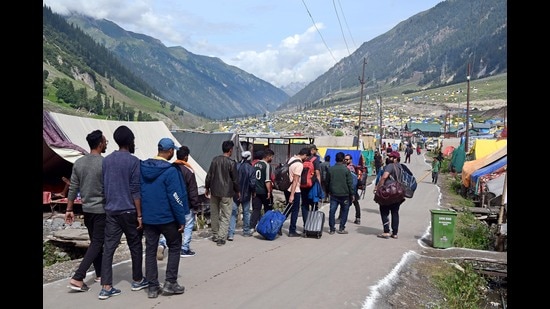Amarnath Yatra concludes, 300k pilgrims take part
Besides mobilising 15,000 additional security personnel in Kashmir, 400 companies of paramilitary forces were deployed for the yatra this year.
The Amarnath Yatra concluded on Thursday, with over 300,000 people taking part in the annual pilgrimage, Jammu and Kashmir Lieutenant governor Manoj Sinha said.

The annual 43-day yatra commenced on June 30 from the twin base camps — traditional 48-km Nunwan-Pahalgam in south Kashmir’s Anantnag and 14-km shorter Baltal in central Kashmir’s Ganderbal.
“It is the call of faith, an unflinching faith, that draws Lord Shiva’s devotees to the shrine every year. Deep inside, everyone knows that they may not return home yet they undertake the arduous trek, overcoming all odds,” said Rohit Jandial, 47, who survived the July 8 cloudburst that left 15 Amarnath pilgrims dead and 40 missing.
Barring the cloudburst, the yatra passed off peacefully after a gap of three years.
In 2019, a total of 342,000 thousand pilgrims had taken part before the yatra was curtailed on August 1 ahead of the abrogation of Article 370 on August 5 that year.
The pilgrimage could not be held in 2020 and 2021 due to Covid-19 curbs.
Given the spike in terror attacks on civilians in Kashmir, the peaceful culmination of the pilgrimage is no mean task for the Jammu and Kashmir administration. Besides mobilising 15,000 additional security personnel in Kashmir, 400 companies of paramilitary forces were deployed for the yatra this year.
Though the CRPF shoulders the responsibility of regulating the pilgrimage, contingents of the army, Border Security Force, Indo-Tibetan Border Police and Sashastra Seema Bal besides Jammu and Kashmir Police, state and national disaster response forces were also deployed for the yatra.
“A security grid was established and control rooms were set up with a three-tier security in place for pilgrims,” said a senior police officer, who did not wish to be named.
“The security for the yatra was discussed and reviewed daily,” said another officer privy to the security details.
“Officers used to carry out surveillance daily and select strategic locations where drones were used along with CCTVs, besides establishing round the clock nakas/cut-off points. We worked at the highest level of alertness,” said the officer. For the first time, every pilgrim was given a radio frequency identification (RFID) card to help track their movement. The tags proved beneficial in tracking pilgrims after the cloudburst.
“The government started planning and mobilising resources six months before the pilgrimage. A series of high-level meetings attended by the lieutenant governor, chief secretary, home secretary, police chief to district commissioners were held to ensure logistics,” said a home department official.






